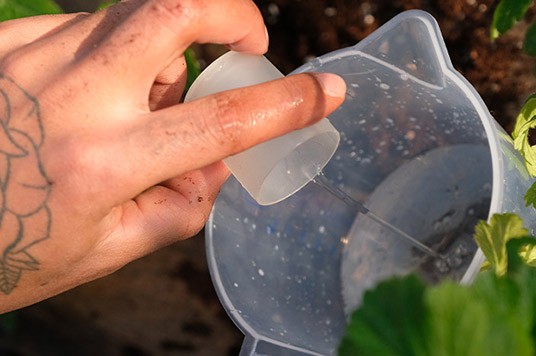How much water do my plants need?
The type, size, age and general health of the plant all influence the plant’s water requirement. This means there is no standard amount of water you should give your plants. In this topic we’ll tell you what water does for your plant and what the signs are that you should water it.

Why should you water your plants?
Plants use their roots to take up water from the soil. Along with carbon dioxide and light, water is used for photosynthesis. This process helps your plant grow. When you add nutrients to your water, you end up with a nutrient solution. This way, water delivers the nutrients of your choosing to your plant.
Evaporating via plant leaves
Plants can only store a certain amount of water. If there is no more room, you plant can’t absorb any more. The substrate you choose partially determines how much water is available for your plant. Water is transported from the roots to the leaves through the stem. This process is called the transpiration stream. When water reaches the leaves, it is evaporated to make room for new, nutrient-rich water to be absorbed by the roots. The evaporation of water through a plant’s leaves is stimulated by light, temperature, humidity and fresh air. You can read more about evaporation in our grow topic about humidity.
When to water your plants
There are a lot of factors that impact your plant’s water requirement. Type, size, age and general health of your plant all matter. As a rule of thumb, give your plants 5-10% of the pot's capacity in water. There are multiple ways to know if the time has come to water them. For instance, you can use a soil moisture sensor. These can be bought for next to nothing at any garden centre. Another option is to use your hands. Just stick a finger in the substrate! The top layer of your substrate will dry out the fastest because of the contact with the air. You’ll get a better indication of the moisture balance a few centimetres below the surface. When it feels dry here it is time to water your plants.
Avoid giving too much or too little water
It is just as bad to give your plants too much water as it is to give them too little. To make it harder to overwater them, use a pot with holes at the bottom. This allows excess water to drain easily. Another option is to add a layer of our Euro Pebbles to the bottom of your pot. This also ensures better drainage.
Do you need help with your (indoor) grow?
If you need help during your grow cycle? Ask for tips about your plant or nutrition. Use this link to get in contact with our Grow Experts at our Servicedesk. We also have online tools available to help you choose your Plagron grow style (Substrate Selector) and later the Grow Schedule Calculator for correct Plagron product combinations and dossage.



